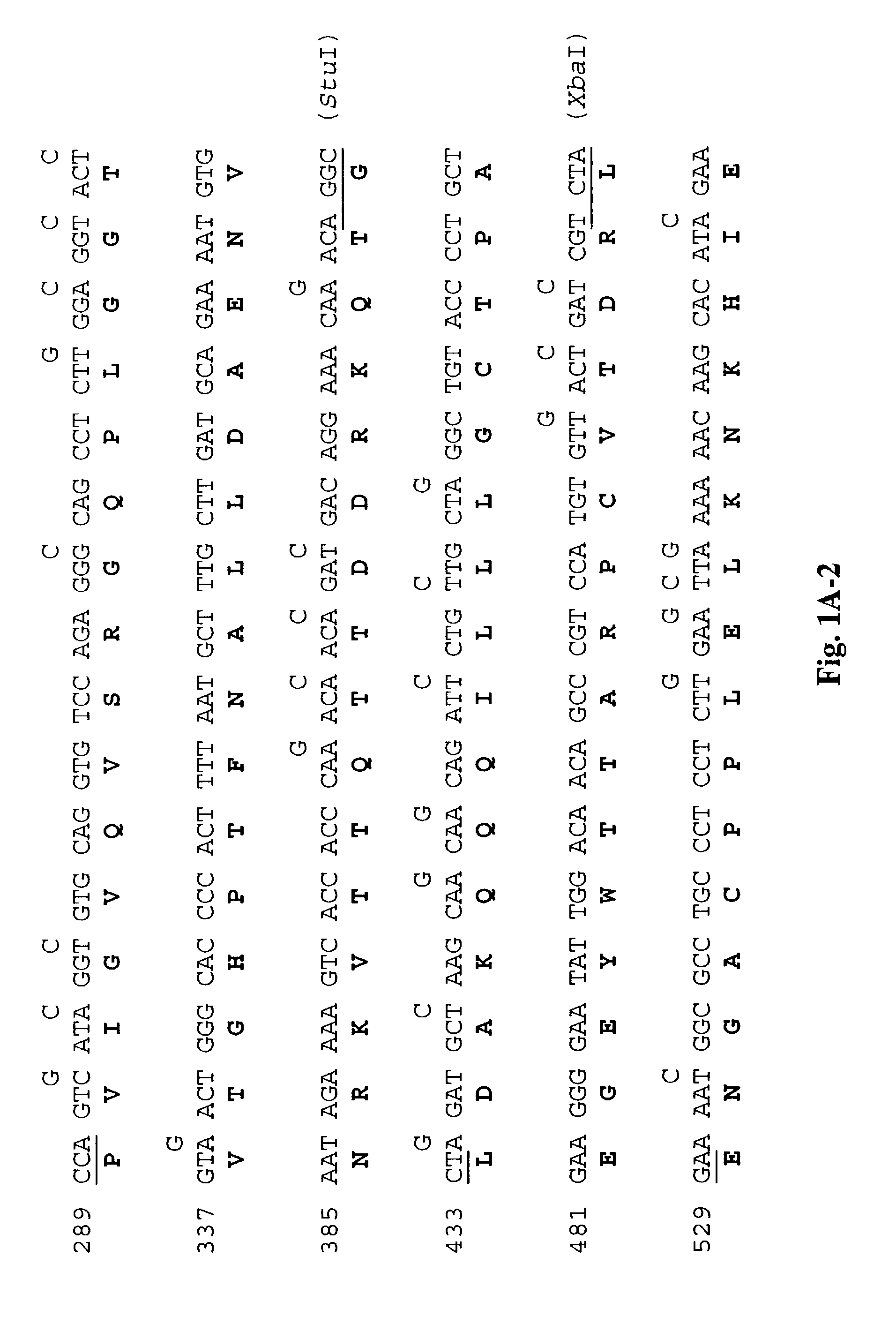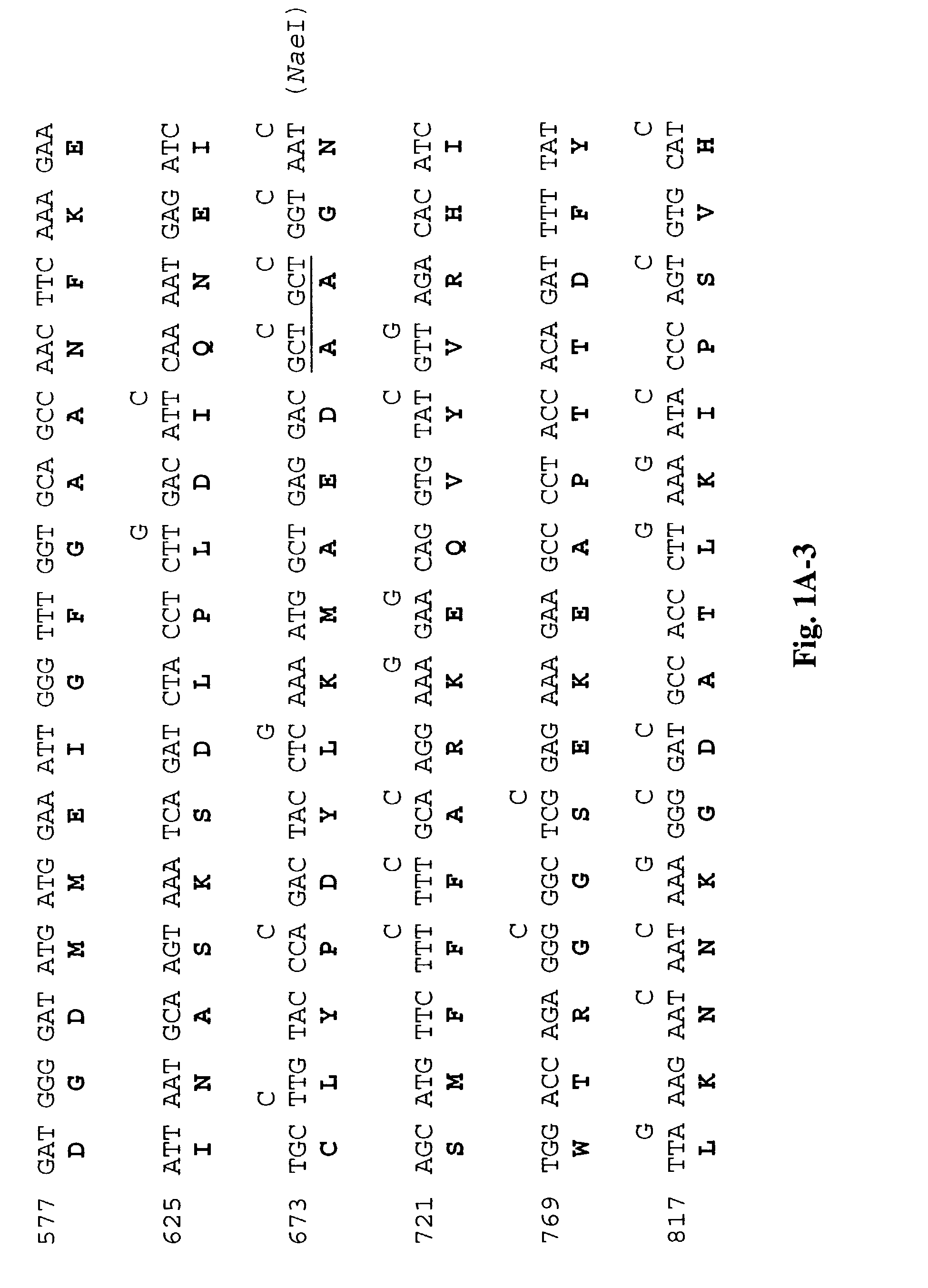Method of constructing a synthetic polynucleotide
a synthetic polynucleotide and polynucleotide technology, applied in the field of synthetic polynucleotide construction, can solve the problems of preventing effective treatment, preventing therapy from entering mainstream clinical practice, and not being able to use a wide range of tissues with selective tissue specific promoters, etc., and achieve the effect of translation efficiency
- Summary
- Abstract
- Description
- Claims
- Application Information
AI Technical Summary
Benefits of technology
Problems solved by technology
Method used
Image
Examples
example 1
[0211]Expression of Synthetic L1 and L2 Protein in Undifferentiated Cells
[0212]Materials and Methods
[0213]Codon Replacements in the Bovine PV (BPV) L1 and L2 Genes
[0214]The DNA and amino acid sequences of the wild-type L1 (SEQ ID NOS: 1,2)and L2 genes (SEQ ID NOS: 5,6) are shown respectively in FIGS. 1A and 1B. To determine whether the presence of rare codons in wild-type L1 (SEQ ID NO:1) and L2 (SEQ ID NO:5) genes (Table 1) inhibited translation, we synthesized the L1 (SEQ ID NO:3) and L2 (SEQ ID NO:7) genes using synonymous substitutions as shown. To construct the synthetic sequences, we synthesized 11 pairs of oligonucleotides for L1 and 10 pairs of oligonucleotides for L2. Each pair of oligonucleotides has restriction sites incorporated to facilitate subsequent cloning (FIGS. 1A and 1B). The degenerate oligonucleotides were used to amplify L1 and L2 sequences by PCR using a plasmid with BPV1 genome as the template. The amplified fragments were cut with appropriate enzymes and se...
example 2
[0223]Papillomavirus Late Protein Translation in Vitro
[0224]Materials and Methods
[0225]In Vitro Translation Assay
[0226]One microgram of each plasmid was incubated with 20 μCi35S-methionine (Amersham) and 40 μL T7 coupled rabbit reticulocyte or wheat germ lysates (Promega). Translation was performed at 30° C. and stopped by adding SDS loading buffer. The L1 proteins were separated by 10% SDS PAGE and examined by autoradiography.
[0227]Production of Aminoacyl-tRNA
[0228]2.5×10−4 M tRNA (Boehringer) was added to a 20 μL reaction containing 10 mM Tris-acetate, pH.7.8, 44 mM KCl, 12 mM MgCl2, 9 mM-mercaptoethanol, 38 mM ATP, 0.25 mM GTP and 7 μL rabbit reticulocyte extract. The reaction was carried out at 25° C. for 20 min, and 30 μL H2O was added to the reaction to dilute the tRNAs to 1×10−4 M. The aminoacyl-tRNAs were then aliquoted and stored at −70° C.
[0229]Results
[0230]As the major limitation to expression of the wild type BPV L1 and L2 genes appeared to be translational in our system...
example 3
[0231]Translation of Wild Type L1 is Efficient in Wheat Germ Extract
[0232]To further test our hypothesis that tRNA availability is a determinant of expression of the wild type BPV1 L1 gene (SEQ ID NO:1), we examined translation of L1 in a cell type in which a quite different set of tRNAs would be available. In a wheat germ translation system, wild type L1 mRNA was translated as efficiently as humanized L1 mRNA, and addition of exogenous aminoacyl-tRNAs did not improve the translation efficiency of either wild type or humanized sequences (FIG. 4B). This indicated that in wheat germ there are sufficient of the tRNAs which are limiting for translation of wild type L1 sequence in RRL to allow efficient L1 translation.
PUM
| Property | Measurement | Unit |
|---|---|---|
| Tm | aaaaa | aaaaa |
| temperatures | aaaaa | aaaaa |
| pressure | aaaaa | aaaaa |
Abstract
Description
Claims
Application Information
 Login to View More
Login to View More - R&D
- Intellectual Property
- Life Sciences
- Materials
- Tech Scout
- Unparalleled Data Quality
- Higher Quality Content
- 60% Fewer Hallucinations
Browse by: Latest US Patents, China's latest patents, Technical Efficacy Thesaurus, Application Domain, Technology Topic, Popular Technical Reports.
© 2025 PatSnap. All rights reserved.Legal|Privacy policy|Modern Slavery Act Transparency Statement|Sitemap|About US| Contact US: help@patsnap.com



